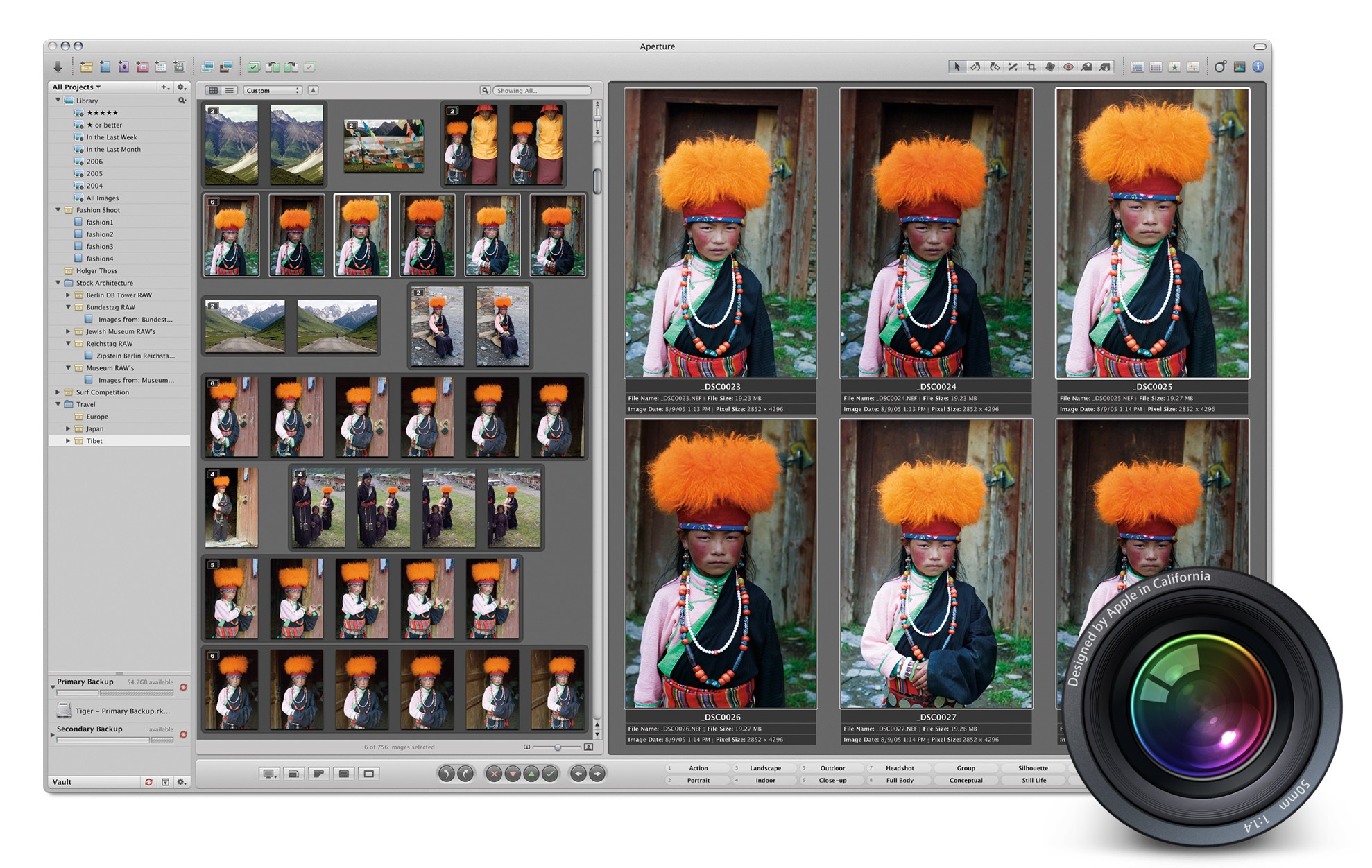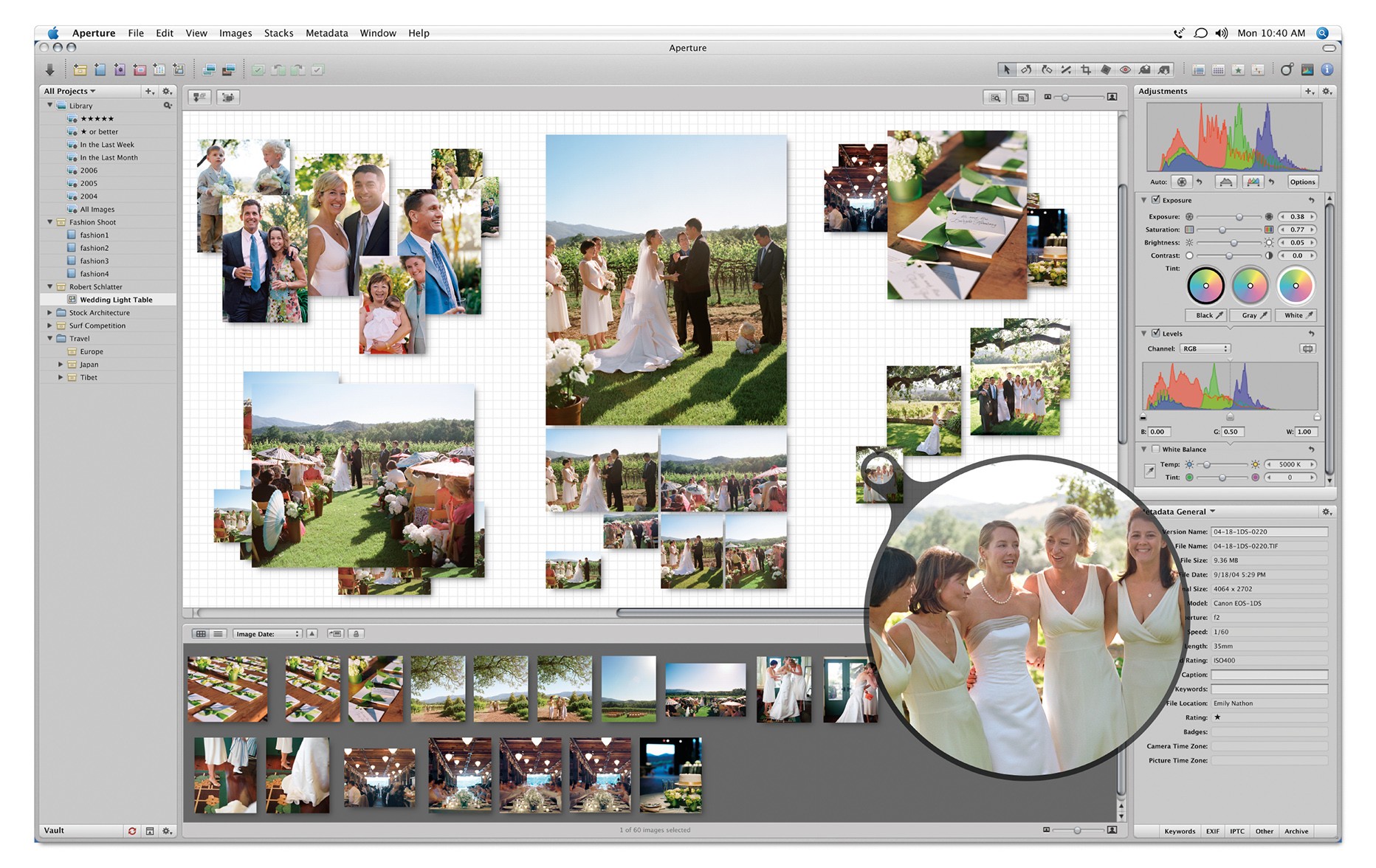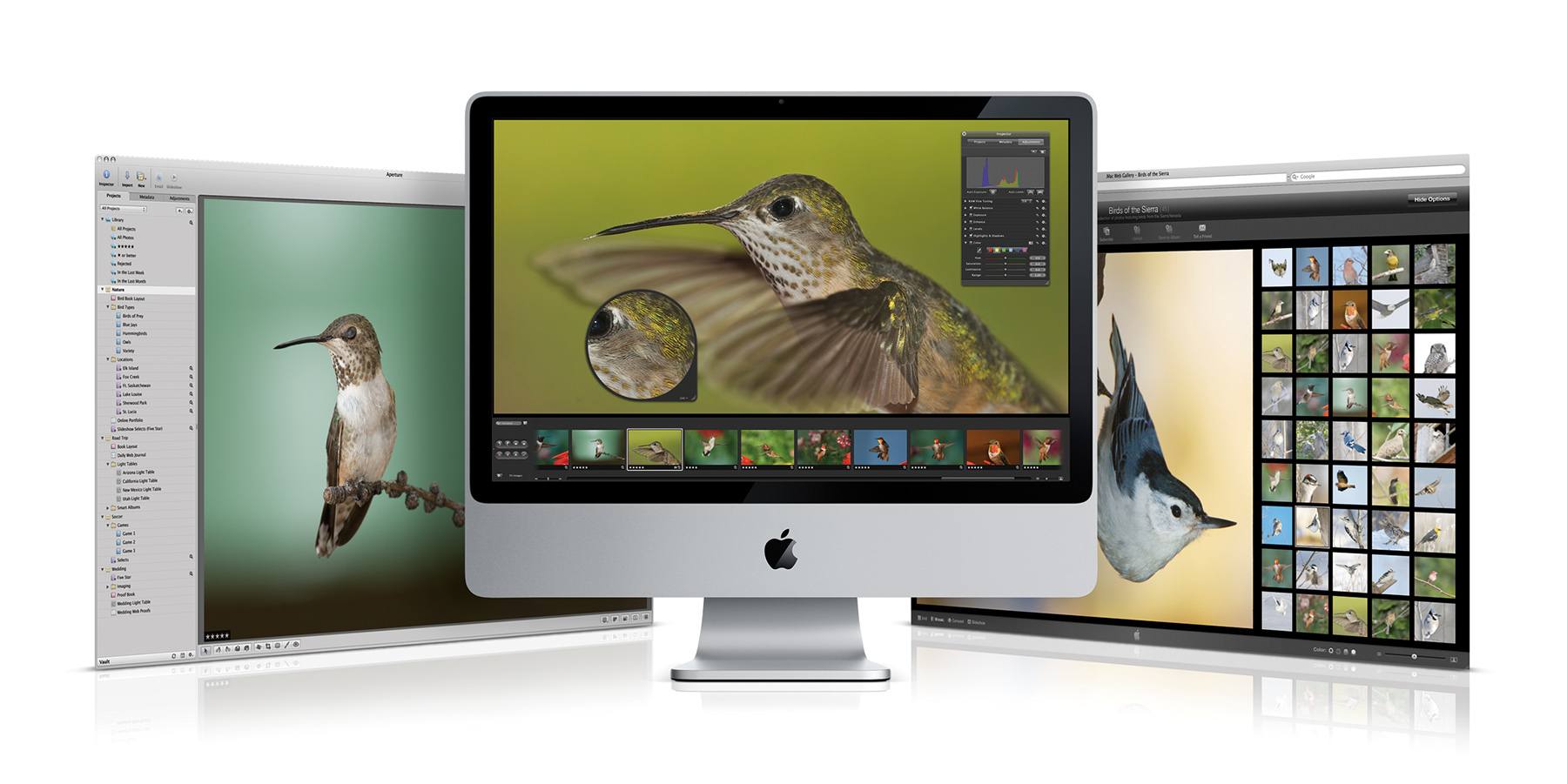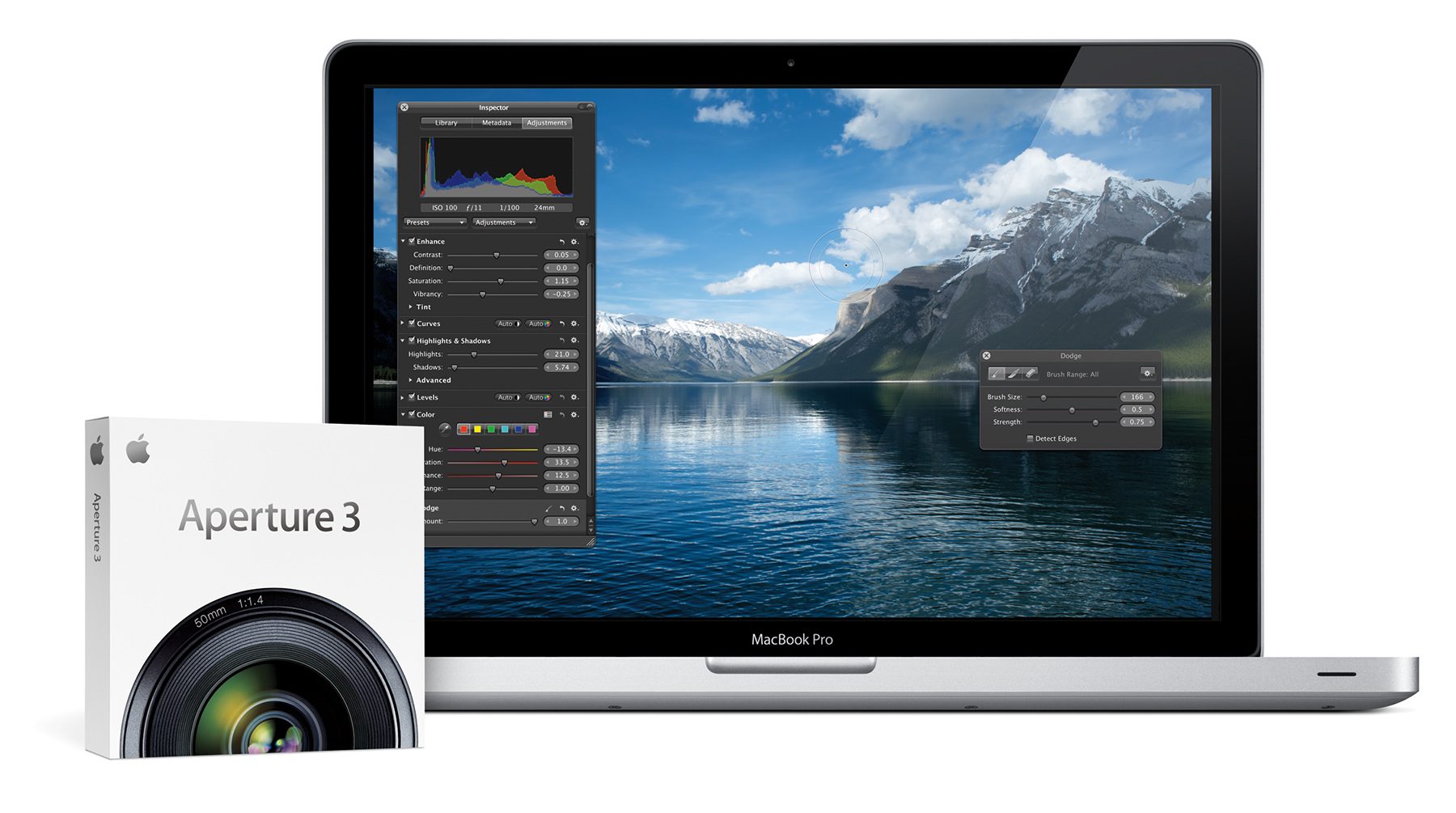For years, iLife defined the Mac experience, or at the very least, its marketing. An iMac or MacBook wasn’t a mere computer; it was a tool for enjoying your music, managing your photos, creating your own songs, editing your home videos, and more.
iLife was brilliant because it was approachable. Programs like iTunes, iPhoto, iMovie, iDVD, and GarageBand were so simple that anyone could just open them from the Dock and get started creating.1
Of course, not everyone’s needs were met by the iLife applications. iMovie users could upgrade to Final Cut, while Logic was there waiting for GarageBand users. And for those needing more than what iPhoto could provide, Apple offered Aperture.
Aperture 1.0 was released in fall 2005. The pitch from Apple was pretty straight-forward:
“Aperture is to professional photography what Final Cut Pro is to filmmaking,” said Rob Schoeben, Apple’s vice president of Applications Marketing. “Finally, an innovative post production tool that revolutionizes the pro photo workflow from compare and select to retouching to output.”
“Until now, RAW files have taken so long to work with,” said Heinz Kluetmeier, renowned sports photographer whose credits include over 100 Sports Illustrated covers. “What amazed me about Aperture is that you can work directly with RAW files, you can loupe and stack them and it’s almost instantaneous—I suspect that I’m going to stop shooting JPEGs. Aperture just blew me away.”
Some may have written off this new program as a Photoshop competitor, but Aperture was really designed to compete with something like Adobe Bridge or later Adobe Lightroom. Ken Rockwell opened his review with this:
Aperture is software to help professional photographers select the very best out of hundreds or thousands of similar images. It also helps find relevant images out of the tens (or hundreds) of thousands of images in our archives. It allows fast and fluid sorting and browsing, even with RAW images. As you know, RAW images are slower to open and browse, so before Aperture it was difficult to flip through hundreds, or even dozens, of RAW images instantly.
Even here in 2018, RAW files can be difficult to deal with due to their size. In 2005, they were all but impossible to manage. Aperture set out to fix that, as Apple’s website said:
Featuring a RAW-focused workflow, Aperture makes RAW as easy as JPEG, letting you import, edit, catalog, organize, retouch, publish, and archive your images more effectively and efficiently than ever before. From capture to output, you work directly with your RAW files, never having to first convert them into another format before viewing, adjusting, organizing, or printing them.
Aperture included traditional organization tools such as albums and folders, and features like the Light Table allowed photographers to recreate more analog workflows.
In short, Aperture was designed to let photographers import a mountain of large RAW files, sort them, perform light editing, and then export them to Finder, the web, or prints. If a user needed to carry out additional editing, Aperture included the ability to round-trip an image to Photoshop and back with just a click. If that all sounds like pro-level stuff, it was, and Aperture’s $499 price point reflected that fact.
The specifications for Aperture 1.0 were as steep as the price. Apple created a free “Aperture Compatibility Checker” application to help determine if your system met the requirements.
Apple praised Aperture for its speed and performance, but those in the real world often complained that it would grind even the Power Mac G5 into dust when creating thumbnails or rendering RAW files. While Aperture could run on some PowerBooks, Apple’s “recommended system” for the application was a Dual 2GHz Power Mac G5 with 2 GB of RAM and a beefy video card.
Then there were the complaints about the tools within Aperture. The program lacked many editing options found in other programs, as Dave Girard wrote at Ars Technica:
If [Aperture] could deliver on the promise of being both fast and produce flawless results, it would be the dream package. At this point it is an expensive and questionable alternative to Camera Raw, a free extension to Photoshop, and Adobe’s Bridge which can batch produce better quality images in arguably less time. For US $500 (Photoshop itself retails for US $649), there is no excuse not to be aware of professional needs like a high-quality sharpen tool, DNG exporting or more basic things like curves, a sampler tool for RGB pixel readings, or retention of EXIF data on output.
Some were more forgiving, such as James Duncan Davidson, who wrote:
Is Aperture perfect? Not at all. It’s definitely a 1.0 product. There are a lot of places in the UI where the performance needs to be tweaked. There are too many places where the response feel of the application is just aggravating. The ultimate RAW conversion quality at 100% isn’t quite there. But for what I’m doing in the heat of the moment during my conference photography, it’s kicking some serious ass.
At the end of 2005, Apple shipped Aperture 1.0.1, which addressed several bugs, including Aperture’s habit of botching EXIF data when exporting files to Finder.
However, Aperture 1’s reputation was set: it was a program that needed a whole lot of computing power for tasks that could be done in other applications more easily.
In fact, by the spring of 2006, rumors were circulating that Apple had disbanded the team behind Aperture, as reported by Think Secret:
Sources familiar with Apple’s professional software strategy said they were not surprised by the move, describing Aperture’s development as a “mess” and the worst they had witnessed at Apple.
Aperture’s problems stem not from any particular area that can be easily remedied but rather from the application’s entire underlying architecture. In the run-up to Aperture’s November release last year, for example, sources report that responsibility for the application’s image processing pipeline was taken away from the Aperture team and given to the Shake and Motion team “to fix as best they can.”
John Gruber did some digging and wrote:
Intrigued, I did some digging. I’ll note up front that my sources aren’t first-hand — i.e. I don’t know anyone directly involved on the Aperture team. That said, my sources at Apple confirmed the basic gist of Think Secret’s report. First, that even by the standards of 1.0 products, Aperture’s development did not go well. A little bit late is one thing; nine months late — which according to my sources is how late Aperture 1.0 was — is a disaster. The term “cluster f–k” is not generally used to describe minor hiccups.
He goes on:
Word within Apple is that Steve Jobs himself is enormously enamored of Aperture. There’s no question what Apple is going to do with Aperture: they’re going to fix it. The questions are just how, who, and when. And with Adobe breathing down their necks with Lightroom, my guess to the last question is “as soon as possible”.
Gruber was correct; Aperture was not killed off. In 2006, Apple swung again, this time with Aperture 1.5. By this time, the price had been cut to $299 after a free trial, and the program supported all shipping Intel Macs.
This release addressed a common complaint about how Aperture stored images on disk. Previously, the program stored all of the files it managed in a database, not unlike Photos today. While that’s fine for many users, it rubbed some pros the wrong way, so Aperture 1.5 could simply reference photos stored in Finder and leave them in their existing locations. For those users juggling multiple hard drives, it was a big deal.
Aperture also gained several new editing tools with this update, including advanced color adjustments and better sharpening options.
Aperture 2.0
In February 2008 Apple released Aperture 2.0, a major overhaul to the battered title.
Aperture 2 boasted 100 new features. Included were an updated user interface that borrowed some things from iPhoto’s then-new Events feature, better metadata editing options, complete control over thumbnails, and more. Tethered shooting was now possible as well, a big win for those working in studios.
Most importantly, Aperture had been re-engineered to be much faster. Importing and rendering RAW files was noticeably faster, and Apple included a “Quick Preview” feature that allowed a user to review a RAW image even as the system was still loading in data from the file.
Version 2.1 brought the addition of a plug-in architecture. This meant in addition to Apple’s new Vignette, exposure, and contrast tools, third parties would be able to write their own adjustment tools for the application. Apple shipped the first plug-in, as highlighted by the company’s PR team:
Available today as a free software update, Aperture 2.1 includes the Apple-developed plug-in, Dodge & Burn, which adds brush-based tools for dodge (lighten), burn (darken), contrast, saturation, sharpen and blur. Over the coming months, third party software developers will deliver image editing plug-ins for localized editing, filters and effects, noise analysis and reduction, fisheye lens correction and more.
[…]“To date, maybe two percent of my photographs needed to be touched up outside Aperture,” said John Stanmeyer, founding member of the VII Photo Agency and contributing photographer for Time and National Geographic magazines. “Now that I can dodge and burn right within Aperture’s new plug-in, I can’t imagine when I’ll have to open any other application to tone my images.”
Things weren’t perfect with Aperture 2; users of the program still had to wait for OS X updates to bring RAW support for new cameras. Plug-ins eventually started showing up, but the technology was slow to take off out of the gate.
Aperture 3
In early 2010, Apple released the final major version of Aperture. Like version 2, this release did more to make the program feel more familiar to iPhoto switchers. At the heart of this effort was the inclusion of Faces and Places, both of which made it easier to quickly find photos of a certain person or location in a large library.
For Aperture 3, Apple continued to focus on speed and stability. Aperture was never an incredibly fast program, but engineers made meaningful improvements this time around. Here’s Ken Rockwell again, this time writing about Aperture 3.
Aperture does all its dirty work in the background, so it works fast regardless of the complexity of the task to which you’ve assigned it.
Finally.
The headline features of Aperture 3 were brushes and adjustment presets. Brushes allowed users to make fine-grained changes to very small sections of a photograph. Adjustment presets offered users one-click changes to their images. Out of the box, Aperture included numerous presets, including options to change white balance, convert to black and white or sepia tone, and a lot more.
Like plug-ins in version 2, this release of Aperture allowed users to install adjustment presets from others, allowing anyone to benefit from other users’ methods of adjusting images.
A year after its release, Aperture 3’s price was dropped to a mere $79.99 and the application found itself in the Mac App Store for the first time.
In 2012, Aperture and iPhoto were updated with the ability to open and operate from a single library. That meant an iPhoto user could upgrade to Aperture without needing to migrate their photos. That same user could even go back to iPhoto for some tasks if they wished.
The End of Aperture
Throughout 2012 and 2013, Apple shipped several additional updates to Aperture for compatibility with new Mac OS X releases and features like Shared Photo Streams.
Apple pulled the plug on Aperture at the same time it killed off iPhoto. Both applications were put to pasture when Photos shipped. Jason Snell, writing at Macworld:
“With the introduction of the new Photos app and iCloud Photo Library, enabling you to safely store all of your photos in iCloud and access them from anywhere, there will be no new development of Aperture. When Photos for OS X ships next year, users will be able to migrate their existing Aperture libraries to Photos for OS X,” reads a statement Apple released to Macworld.
While Aperture development (beyond minor updates to ensure OS X Yosemite compatibility) will cease, the company has no intention to abandon creative professionals. Development of both Logic Pro and Final Cut Pro continues.
As promised, the last revision of Aperture was version 3.6, shipped in October 2014 to add support for OS X Yosemite.
There are a lot of things to consider when thinking about Aperture’s troubled existence.
No doubt the program struggled to shake its early reputation. The performance woes and underwhelming feature set in the first version tainted people’s opinions in a way that was hard for Apple to shake. I have no doubt that some who paid that initial $499 price tag were disappointed by their investment.
Despite persistent rumors that it would be cancelled, Aperture improved through its two major revisions. Apple added much-needed tools and features, all while making the software more responsive and less frustrating to use.
However, even as it added pro-level features to Aperture, Apple also worked to bring features up from iPhoto. Many pros weren’t interested in things like face detection, but Aperture gained it anyway.
While Apple has plenty of Aperture’s blood on its own hands, Adobe may have been holding the actual murder weapon. In 2005, Adobe Bridge was taking off as an import and organization tool, and Lightroom grew out of that, launching two years later. Adobe poured resources into Lightroom, making improvements on a regular basis.
It was clear to photographers that Lightroom was a focus for Adobe, while Aperture was a side project at best for Apple, and at worst, a distraction.
Thanks to all of these factors, users found it difficult to fully trust Aperture in their professional workflows. As that was the whole point of the program, it was probably doomed to fail.
- As these things often do, over time these applications grew more complex and maybe even bloated, but that’s a story for a different time. ↩︎





